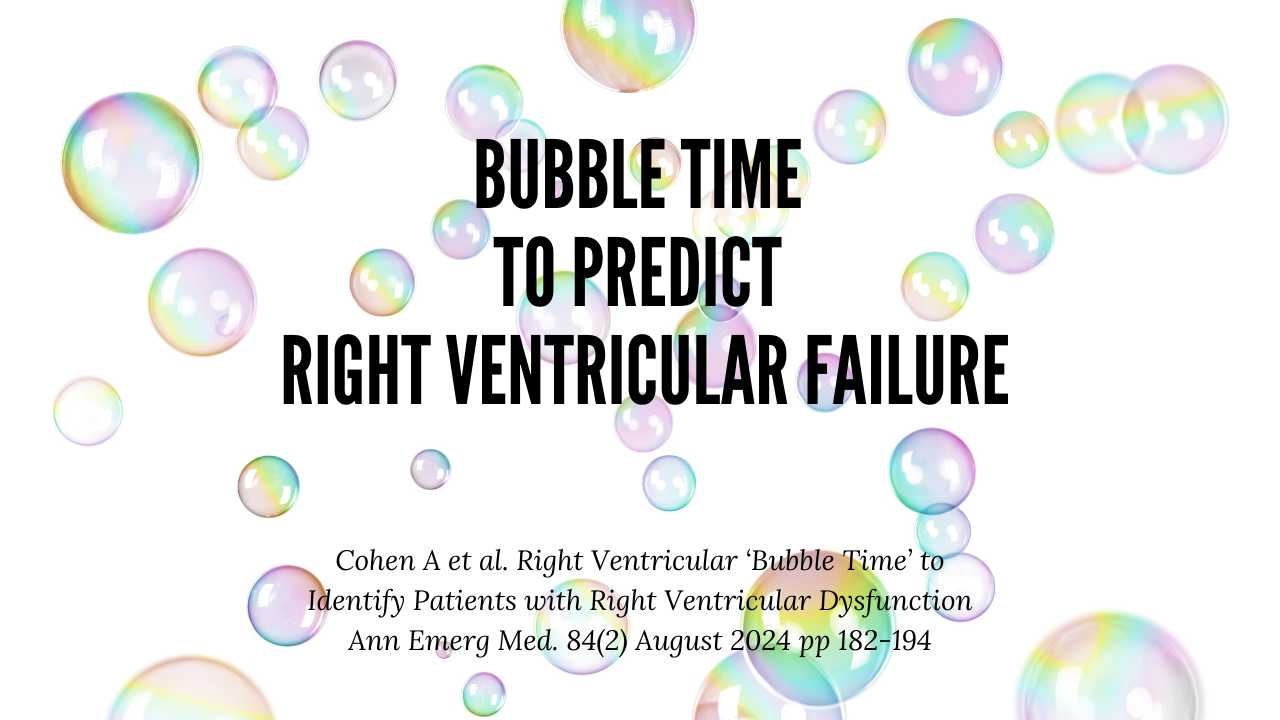Right Ventricular(RV) failure presents a significant challenge in the emergency department. It can affect our resuscitative efforts. The only way to diagnose it is with echocardiography. That may not be an option in many emergency departments and POCUS skills may not be adequate to give us the necessary information we need.
This study proposed “a novel method of identifying RV dysfunction using RV “bubble time,” which is the duration of time bubbles from a saline solution flush are visualized in the RV on POCUS echocardiography.”
“We hypothesize that it is possible to identify a cutoff value for RV bubble time that has high sensitivity and specificity in identifying patients with and without RV dysfunction, compared with comprehensive echocardiography.”
What They Did
This was a prospective diagnostic cohort study of a convenience sample, where patients were included by emergency ultrasound fellowship-trained faculty members and advanced emergency medicine ultrasound fellows. Comprehensive ultrasounds were performed by cardiologists.
Patients were eligible if:
- 18 years or older,
- had an 18G or 20G intravenous catheter in place within 2 cm of the antecubital fossa and
- had comprehensive echocardiography ordered by the emergency physician.
The patient was placed in a supine position. A phased array transducer with cardiac presettings was used with an initial parasternal long view axis echocardiographic view. This was followed by a subxiphoid view and the view providing optimal visualization of the RV was used for the study.
Once the view was established, a member of the study team would vigorously shake a 10-mL saline solution flush for 5 seconds, then rapidly administer the 10-mL saline solution flush within 5 seconds into the patient’s intravenous catheter.
The bubble time was the total duration of time from the appearance of saline solution bubbles in the RV to the disappearance of bubbles from the RV.
What They Found
206 patients were approached, and data from 196 patients were analyzed, where the top 5 indications for echocardiography were:
- chest pain (27.0%),
- abnormal ECG (15.8%),
- dyspnea (15.3%),
- heart failure (7.1%), and
- syncope/collapse (6.1%).
In the 127 patients without RV dysfunction, the median RV bubble time was 21 seconds (IQR 12 to 32) compared to the 69 patients patients with RV dysfunction , which was 62 seconds (IQR 52 to 93).
- The sample size was small.
- There is a possibility of selection bias due to a convenience sample being used.
- There was no blinding of sonographers to the patient’s appearance, which could also introduce biasin terms of bubble time estimation.
- Third, all the POCUS studies were performed by ultrasound fellowship-trained physicians, which may not extend to all emergency physicians,
- This study had a large number of patients with RV impairment.
- The bubble time of 40 seconds or more is associated with RV dysfunction on either view however, the bubble time between subxiphoid and parasternal long views were not directly compared.
- Haemodynamically unstable patients were not included in this study.
- All IV cannulas were placed within 2 cm of the cubital fossa.
My Take on This
For the full review go to EMMastery.com.
References
- Cohen A et al. Right Ventricular ‘Bubble Time’ to Identify Patients with Right Ventricular Dysfunction Ann Emerg Med. 84(2) August 2024 pp 182-194










